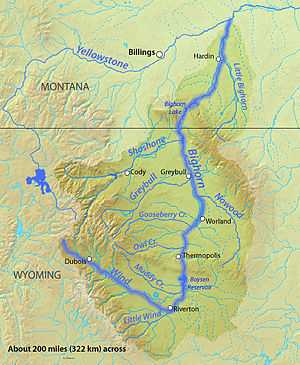Little Bighorn River
| The Big Horn River, showing the Little Bighorn River as a tributary | |
|---|---|
 | |
| Origin |
Bighorn Mountains 44°47′21″N 107°48′44″W / 44.7893°N 107.8122°W |
| Mouth |
Bighorn River near Hardin, Montana 45°44′17″N 107°34′10″W / 45.73806°N 107.56944°WCoordinates: 45°44′17″N 107°34′10″W / 45.73806°N 107.56944°W[1] |
| Basin countries | Big Horn County, Montana and Sheridan County, Wyoming |
| Mouth elevation | 2,884 feet (879 m)[1] |
| River system | Yellowstone River |
The Little Bighorn River[1] is a 138-mile-long (222 km)[2] tributary of the Bighorn River in the United States in the states of Montana and Wyoming. The Battle of the Little Bighorn was fought on its banks in 1876, as well as the Battle of Crow Agency in 1887.
The Little Bighorn rises in extreme northern Wyoming, along the north side of the Bighorn Mountains. It flows northward into Montana and across the Crow Indian Reservation, past the towns of Wyola, Lodge Grass and Crow Agency, and joins the Bighorn near the town of Hardin.
The battle site, now included in the grounds of Little Bighorn Battlefield National Monument, is approximately five miles south of Crow Agency, on the eastern side of the river.
Source of Name
In 1859, W.F. Reynolds led an government expedition up the Big Horn River to the mouth of Big Horn Canyon, and then southeast along the base of the Big Horn mountains. He camped on the Big Horn just below the mouth of the Little Bighorn on September 6, 1859. He noted in his journal for that day that the Indian name of the Big Horn river, into which the Little Bighorn empties, is Ets-pot-agie, or Mountain Sheep River, and this generates the name of the Little Big Horn, Ets-pot-agie-cate, or Little Mountain Sheep river.[3] The trappers who came to the Big Horn Mountains in the fur trapping era continued the usage of the English translation of the Indian names, and the names for both rivers have come down through history.[3]
Captain Reynolds had Jim Bridger as a guide and interpreter, so the information about the source of the name was confirmed by Reynolds from Indian sources through Bridger.
Variant names
The Little Bighorn River has three other official variants of the name, including Little Horn River, Custer River, and Great Horn River.[1]
A historical variant of the name is the Greasy Grass River. From the 1500s to the 1800s, the indigenous Crow people knew the river as the Greasy Grass River, reportedly because the abundant grass that grew in the river bottoms that would gather heavy dew in the morning which, in turn, would wet moccasins and cause them to look greasy. The name "Greasy Grass" was also used for Lodge Grass Creek, a tributary of the Little Bighorn. The Lakota Sioux, who began to contest control of this area with the Crow in the 1840s to 1860s, as they pushed westward, continued the use of this name.
In Lakota, the Little Bighorn River is called Pȟežísla Wakpá.[4]
See also
| Wikimedia Commons has media related to Little Bighorn River. |
- List of Wyoming rivers
- List of rivers of Montana
- Montana Stream Access Law
Notes
- ↑ 1.0 1.1 1.2 1.3 "Little Bighorn River". Geographic Names Information System. United States Geological Survey.
- ↑ "The National Map". U.S. Geological Survey. Retrieved Feb 9, 2011.
- ↑ 3.0 3.1 Raynolds, W.F. Report of the Exploration of the Yellowstone River 1859. Washington Government Printing Office 1868. Retrieved 12 June 2013.
- ↑ Ullrich, Jan, ed. (2011). New Lakota Dictionary (2nd ed.). Bloomington, IN: Lakota Language Consortium. p. 995. ISBN 978-0-9761082-9-0. LCCN 2008922508.
| ||||||||||||||||||||||||||